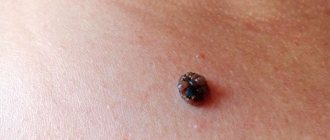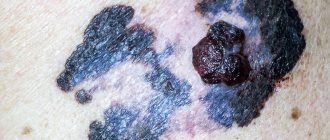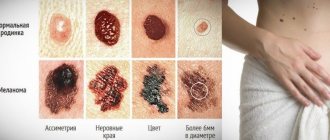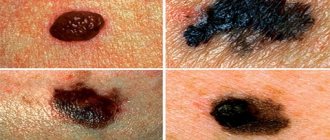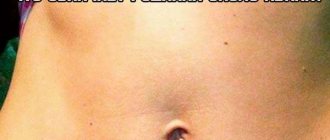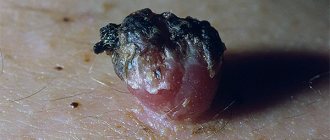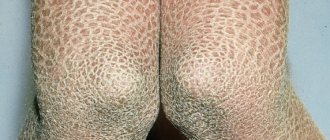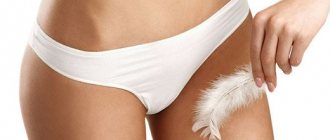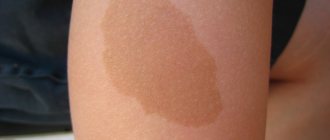A mole hurts - what does it mean? Moles, or nevi, are new growths on the skin that occur when melanin accumulates in skin cells. Despite the fact that they are benign in nature, under the influence of certain factors they can degenerate into cancerous tumors (melanomas).
With prolonged irritation, such growths often become inflamed, especially if they are located in places subject to constant friction or other mechanical stress. If a mole hurts when pressed, this should serve as a good reason to consult a doctor and be sure to take measures to eliminate the inflammatory process occurring in its cells.
Why does a mole hurt?
There are several main reasons why a mole hurts.
Most often, pain occurs as a result of injury.
This is also accompanied by minor bleeding, swelling and hyperemia of the surrounding soft tissue.
If the mole hurts and itches, and new nevi appear, hormonal changes are suspected.
This occurs more often in women during pregnancy.
Painful moles are caused by the following reasons:
- Injuries - a hanging mole in particular often hurts, which can easily be touched by clothing, a washcloth or jewelry, depending on its location. But other types of moles can also be injured, sometimes this happens in beauty salons when performing intense massage, using anti-cellulite cups, or performing depilation. More often, nevi located in the armpits, pubis, collar area, and on the folds of the lower and upper extremities are injured. Often the cause of pain is an injury to a mole while using a razor. Any damage to a benign formation should not be ignored, since even minor scratching can provoke malignancy, which poses a direct threat to human life.
- Increase in size - the cause of such changes is often hormonal changes, but sometimes the mole grows and hurts when the process becomes malignant.
- Prolonged exposure to direct sunlight or staying in a solarium leads to burns. In this case, the mole hurts and may itch, but after 3-5 days the discomfort goes away on its own. If after being under the hot sun the pain does not disappear for 7 or more days, you should see a doctor and undergo an examination, the process of malignancy (malignancy) may have begun.
- Inflammatory processes - most often occur when a mole is damaged and infection enters, which causes hyperemia, pain and even swelling.
- Thermal burn of the skin - exposure to hot steam or liquid, fire, high temperatures causes burns of varying degrees of severity, the most sensitive areas are moles and age spots, where increased pain is felt.
- Hypothermia or overheating of the body - with any deviations in body temperature from the norm increases the sensitivity of the skin. Not only existing nevi can hurt, but also the site of a mole removed in the recent past.
What factors can provoke pain in a mole?
When examining a newborn baby, you can notice moles on his body - such nevi are congenital. They are often hereditary. Over the course of a person's life, new moles may appear. The prerequisites for their occurrence can be associated with various events :
- injury to the skin and soft tissues;
- exposure to direct sunlight;
- increasing radiation levels;
- changes in hormone balance;
- damage to the body by infection or viruses.
© shutterstock
Experts name two groups of reasons when pain appears in a mole - exposure to external stimuli and internal causes. Pain in a mole is also observed if there is an impact on the formation itself, nearby nervous tissue, blood vessels, sweat or sebaceous glands, and hair follicles.
Usually a mole begins to hurt if its owner suffers injury. Rubbing with clothing, careless hygiene procedures, blows, cuts, any burns, or pricks with a sharp object cause damage to the integrity of the nevus. Its membranes are destroyed, the endings of the nerve tissues lose their protection, so pain appears. The symptom may be associated with changes in body or environmental temperature. Its fluctuation accompanies many diseases. Nevi hurt when the functions of internal organs or endocrine and gonads are impaired. You should familiarize yourself with the common reasons when a mole hurts in more detail.
Signs of malignant degeneration of a mole
How to assess the danger if a mole hurts and determine the need for surgical intervention?
Unpleasant sensations can be the first symptoms of malignant degeneration.
How quickly and rapidly malignancy occurs depends on several factors.
For example, frequent exposure to sunlight significantly accelerates the process of malignancy.
Therefore, it is very important to periodically examine pendulous or other moles located in areas of increased trauma.
If any pathological changes are detected, you should consult a doctor.
Signs of malignancy:
- violation of symmetry (all benign moles are completely symmetrical, with the exception of congenital ones)
- uneven contours (malignant nevi are characterized by blurred contours and unclear edges; in a healthy state, a mole has clear contours and smooth edges)
- change in color (if dots, stripes appear on a mole, or it becomes multi-colored, this indicates its malignancy)
- increase in size (in a normal state, this is possible in adolescence or in women during pregnancy; in other cases, a sharp, causeless growth of benign formations requires examination and, in most cases, removal)
- any pathological changes (the occurrence of bleeding, cracks or the formation of crusts for no particular reason are the causes of degeneration)
In some cases, additional symptoms of malignancy of the process may include:
- swelling and pain of a mole
- peeling
- thickening of the tumor
- a feeling of burning and itching, periodic tingling in the area where the mole is located
- causeless formation of rashes around the nevus, similar to an allergic rash
Sometimes a mole hurts after removal, which can also mean the development of a cancerous process or the growth of a new benign nevus.
More often this is due to incomplete excision of melanocytes, cells that accumulate as moles.
When pain in a mole is especially dangerous
If a person notices that his mole hurts, the symptom occurs periodically or constantly, he must undergo a medical examination. Particularly dangerous are situations when the main manifestation is pain, accompanied by others :
- the mole noticeably grows (in width or upward), takes on an asymmetrical shape, one of its parts becomes larger;
- the usual outlines of the growth will change, its edges will become uneven, “torn”;
- change in the color of a mole or its sections, coloring it in an uneven shade, the appearance of bright areas (very dark, light, bluish, red);
- the mole becomes very dry, its tissues crack;
- redness and pigmentation begin to appear in areas of the skin around the nevus;
- active appearance of several new ones next to the mole that hurts;
- severe itching of the mole, bleeding from its body, wetting of the surfaces, formation of a crust on the surface, suppuration.
Paying more attention to all moles, especially those that hurt, monitoring and assessing their changes allows you to identify dangerous pathologies and begin treatment in a timely manner.
Interesting8Not interesting0
Why does the process of malignancy of moles occur?
Any changes in the functioning of the body require consultation and examination by a qualified specialist.
It is very important to undergo diagnostics for timely detection of cancer and factors that provoke malignancy.
First of all, direct sunlight has a bad effect not only on moles, but also on the skin in general.
The aggressiveness of ultraviolet radiation leads to the development of cancer processes quite quickly.
It is no less dangerous to scratch the areas where moles are located.
Any damage to their integrity can trigger the process of degeneration or cause the introduction of an infectious pathogen.
Also, in areas where moles rise above the surface of the skin, you should not use hard washcloths.
Because there is a high risk of damage.
Main causes of pain
A benign birthmark is formed in the middle layers of the skin and passes through many receptors. Any damage, pressure, and the mole begins to hurt. If unusual sensations are detected, the triggering factors should be carefully examined. The greatest danger is pain that occurs in the area around the growth, but is not strictly concentrated in the tumor-like growth. There are several reasons for the problem.
Mechanical damage
Trauma is the leading cause of pain and inflammation in the nevus. It happens due to an unfortunate location on the body. Dangerous places:
- back, neck. The growths are often damaged by a hard washcloth, jewelry, straps from clothes or bags, belts, belts;
- groin area. Hanging tumors pose the greatest threat; they interfere with hygiene procedures. Accidentally damaged by a razor, epilator, or underwear. The result of injury is bleeding, infection with a good outcome;
- buttocks. A dangerous place for moles; it is difficult to see the growth on your own and prevent damage. Frequent causes of pain are injections, blows, rubbing with a hard washcloth, massage brush;
- stomach. The body in this part is covered with clothing, the integrity of the mole is easily damaged by the belt of trousers, skirts, or rubbed with low-quality material;
- head, face. Injuries are caused by a comb, styling devices, other care items, and hair coloring compounds;
- leg, hand. The most susceptible parts of the body to various injuries. The nevus becomes inflamed from a scratch from a cat, dog, insect bite, blow, or fall.
The location of moles in unfortunate places, the structure in the form of a hanging papillomatous wart, increases the chances of injury. From contact with clothing, household appliances, and other objects, the epithelial cover is destroyed, and the nerve endings are exposed in response to the stimulus. If the growth is not subject to friction, only a doctor can determine the causes of the mole's tingling and pain.
Burn
Damage and ultraviolet radiation have an adverse effect on moles. The sun can provoke the degeneration of a harmless formation into a malignant one. Scientists have proven that ultraviolet radiation has a negative effect on pigmented areas. Dermatologists and oncologists recommend protecting tumors as much as possible from direct sunlight and solariums. Tanning is only permitted with strong sun protection.
The danger comes from burns from chemicals, household appliances, open fire, etc.
Decrease or increase in temperature
The skin is penetrated by a large number of nerve endings that send signals to the central nervous system. Takes an active part in the process of thermoregulation. For humans, the optimal ambient temperature is 18-20 degrees. Temperature changes, sudden fluctuations, cause a reaction. The skin along with the nevus experiences stress.
Any undesirable effect on a mole gives rise to the beginning of a pathogenic process inside, leading to the degeneration of a harmless formation into a malignant tumor with metastases.
What does a dermato-oncologist do?
The specialist studies nevi and prescribes tests to determine the nature of the neoplasm.
Conducts differential diagnostics, assesses the likelihood of transforming a benign process into a malignant one.
First, a visual inspection is carried out.
Then specialized equipment is used for a more detailed study - a dermatoscope.
If there are risks of malignancy or the process of malignancy has already started, surgical intervention is prescribed.
The operation is performed by a surgeon using general or local anesthesia.
Forecast
After cosmetic removal of moles, as a rule, the healing process does not take more than 10 days. There are no scars left on the skin, the person does not feel any discomfort.
After removal of the formation for medical reasons (surgical intervention), the result of further treatment depends on the results of histology. If the histology does not reveal cancer cells, then you should wait for the scar to heal completely. In case of oncology, nearby lymph nodes may be additionally excised. If metastases are present, chemotherapy or radiation treatment is prescribed.
Mole removal methods
If a mole has enlarged and hurts for no apparent reason, as well as if there are pathological changes in its structural structure, its removal is prescribed.
If the development of melanoma is suspected, a surgical method is used.
During the operation, not only the mole itself is excised, but also the healthy tissue surrounding it.
The disadvantage of this procedure is the formation of postoperative scars.
This is due to the need to remove the neoplasm together with adjacent structures, the diameter of which should be at least 3-5 cm.
After the operation, the removed material is sent for histological analysis.
The use of liquid nitrogen at low temperatures – cryodestruction.
This technique is often prescribed to remove birthmarks that are at the level of the skin and represent a cosmetic defect.
During the procedure, the nevus is frozen, after which it shrinks and a crust is formed, which prevents infection.
Over time, the crust falls off and healthy structures are regenerated in its place.
Sometimes, if melanocytes are not completely eliminated, a repeat procedure may be required.
Since there is a high probability of relapse.
Moles that rise above the surface of the skin are sometimes cauterized using a needle electrode.
As a rule, the removed tumor is sent for histological examination to determine its nature.
After the procedure, a crust forms; after a while, an almost imperceptible scar may remain.
Removal of a nevus using laser radiation is considered one of the most effective and least traumatic operations.
Used to remove benign formations located on open areas of the skin, for example, on the face.
Laser equipment is highly accurate due to which the surrounding healthy tissue remains undamaged.
When eliminating small moles after restoration of tissue structures, there are no scars or scars.
Radiosurgery is also used to remove tumors protruding above the surface of the skin.
The technique is based on the influence of radio frequency waves, is the safest and completely non-contact.
After the procedure, the adjacent tissues with the surgical field are restored quite quickly.
Good equipment allows you to make cuts of various depths and any configuration.
Warning symptoms and the need to consult a doctor
When a mole hurts when touched, it is important to pay attention to the presence of accompanying symptoms. They may indicate its degeneration into a malignant skin tumor. Thus, the process of malignancy of a nevus may be accompanied by:
- itching in the area of the tumor,
- increase in growth,
- bleeding mole,
- constant or periodic pain even without touching the nevus,
- the occurrence of asymmetry of the mole.
Remember! If there is redness and swelling around the mole, or it begins to peel off, you should immediately consult a specialist. The growth may have to be removed, thereby preventing the dangerous consequences that the process of its degeneration into melanoma can lead to.
The neoplasm, which has begun to change its shape, requires special care. Normally, it should be even, so that when drawing a conditional line in the middle, both sides have approximately the same dimensions. If the mole has increased in size and hurts, and at the same time there is a clear deformation of it, it is necessary to urgently take action. A similar deviation is observed at the beginning of the process of its malignancy.
Another warning symptom is a change in the color of the birthmark. Degeneration into a malignant formation is also indicated by the situation when the mole swells, becomes dark brown, or even black, and red dots appear on its surface. Do not neglect such signals, so as not to encounter a problem that is more dangerous than the unaesthetic appearance of nevi on the body!
Which doctor should I contact?
If a mole is inflamed and bothers you, which doctor should you go to? First, you need to visit a dermatologist’s office, who will conduct an initial examination and collect anamnesis. Often such inflammation is not dangerous and can be eliminated quite easily.
But if the doctor has suspicions about the nature of the neoplasm, or if after therapeutic measures the mole still itches and hurts, the patient may be referred for a consultation with an oncodermatologist. It is this specialist who will prescribe the necessary diagnostic tests and, if necessary, carry out further treatment.
Healing after mole removal: can it hurt and for how long?
What to do if a mole hurts after removal, as well as the area around it?
Sometimes after surgery you may experience discomfort, pain and even a burning sensation.
More often this is observed after surgical removal of the nevus and adjacent tissues.
Minor soreness and discomfort may be present for up to one week, and an itchy sensation may also occur.
After removing the nevus, the wound and surrounding areas are treated with antibacterial ointments or a weakly concentrated solution of potassium permanganate twice a day for 5-7 days.
After surgery, a scab (crust) is formed at the site of mole removal, which protects the damaged area from infection.
In order not to injure the healing surface in the first 7-10 days, the use of a washcloth, taking a bath, sauna, or applying cosmetics is strictly prohibited.
After 8-9 days, the scab disappears, and healthy pink skin appears underneath.
Very often, patients are interested in whether it can hurt and how long it will take for the skin to heal after removal of a mole?
Pain may be present, but not always, and as a rule, if all medical recommendations are followed, it disappears within 2-3 days.
The main condition for rapid recovery is the complete exclusion of direct sunlight.
If the operation is planned to be performed in the summer, it is necessary to avoid going to the beach for 3-4 weeks.
Also reduce the frequency of being outside in the open sun.
Treatment options
The most effective treatment for nevus is removal. The operations are carried out in a few minutes, and recovery takes no more than four days. But the period depends on the quality, depth and size of education. Modern medicine distinguishes several methods of surgical intervention:
- laser;
- radio waves;
- electrocoagulation;
- cryodestruction;
- surgery.
Laser therapy is suitable for removing moles on the head; it allows you to control the depth of penetration of the rays. There is no pain during the operation; the procedure lasts about 10 minutes. After healing there are no scars left. But the quality of the operation directly depends on the power of the medical equipment.
Radio wave therapy is a quick and painless way to eliminate moles on the back and other parts of the body. The doctor may take tissue for examination and then perform the procedure. The operation takes about 15 minutes, and the patient recovers within a few days. No scars remain. Only convex nevi can be removed; it is not suitable for flat ones.
Electrocoagulation is considered a painless procedure. The doctor independently controls the depth of current penetration. But it will not be possible to remove large moles or those that have grown into the lower layers of the epithelium in this way.
Cryodestruction is the use of nitrogen. The substance can eliminate nevi of any size and depth in just a few minutes. A dense crust forms at this site, protecting against infections; it will fall off over time. But the method has some disadvantages: after the wound heals, scars may remain, and a repeat procedure will be required, since during the operation it is impossible to control the depth of action of nitrogen . Sometimes healthy tissue near the mole is affected, which will only worsen the situation.
Malignant tumors, regardless of where they may grow, are removed only by surgery. Surgeries allow you to remove nevi from the deep layers of the skin, this eliminates the recurrence of inflammation. The patient must be given local anesthesia or anesthesia. After the procedure, stitches are placed on the area of removal; in almost all cases, a scar remains.
All methods, except the last one, are suitable for eliminating benign formations. Only surgeons remove melanoma; after the operation, they prescribe chemical or radiation therapy, which will prevent the patient from getting sick a second time.
What complications may arise after mole removal?
If the scar hurts after removing a mole, a relapse is possible.
This happens in cases where, during surgery, not all melanocytes were eliminated; new birthmarks begin to form from the smallest particles remaining.
If moles grow again, they may need to be removed again.
If the wound becomes infected during the postoperative period, the following symptoms may occur:
- increased feeling of itching, weeping
- bleeding
- purulent contents are released from the wound
- the place of the mole is swollen and hurts
- swelling of surrounding tissues (lasts more than three days)
- increase in body temperature (over 38 degrees)
Who to contact and what to do
After injury or sunburn of a birthmark, acute pain occurs. In this regard, many patients try to visit a dermatologist as quickly as possible. You need to consult a specialist, but this should not be done right away. The first symptoms, such as discoloration and swelling, make it difficult to make a diagnosis. After 2 days a crust will form, which will fall off on its own after 14 days. This means that the wound has healed. It is recommended to contact a doctor when the inflammation decreases.
If suppuration is visible or the damaged growth hurts when pressed lightly, a doctor’s intervention is needed.
Having examined the sore spot and discovered an active inflammatory process, he prescribes complex therapy:
- taking local antibiotics;
- anti-inflammatory compresses;
- painkillers.
If the tumor hurts and swells, it is recommended to visit a dermatologist.
After conducting an examination, he can send you to an oncologist. After studying the examination results, appropriate therapy is prescribed. Before visiting a doctor, you can use the harmless advice of traditional medicine:
- dip a cotton swab into the vinegar solution;
- press it to the disturbing area and leave for 10–15 minutes;
- can be disinfected with brilliant green or hydrogen peroxide.
Try to remove all irritants that touch the wounded birthmark.
Inflammation
The homeland hurts when pressed - the cause may be inflammatory processes. Untreated damaged tubercles provoke their appearance. Usually, a nevus can be accidentally caught and simply not noticed. Microbes get inside the wound and begin their “dark” business. The skin around the mole turns red, swells and hurts. A kind of deping rim appears. It prevents diseased cells that are trying to actively reproduce from spreading. In this case, you cannot do without a specialist. As a last resort, see a dermatologist, but it is best to see a dermatologist. It determines the nature of education.
You can try to get rid of the problem at home. But these measures are carried out at the initial stage of the inflammatory process. And even if you managed to relieve inflammation, consulting a specialist would not hurt. Only he will be able to determine the nature of the inflammatory process and prescribe appropriate treatment.
What to do if a mole becomes inflamed
The mole hurts when pressed, what should I do? The most important step is to stop self-medicating and panicking. Redness does not always indicate that rebirth is occurring. To this symptom many others must be added.
Now recommendations on what to do:
- Soak a gauze pad: one part chlorhexedine, the same amount of dimexidine and two parts water.
- Apply the compress to the inflamed area for half an hour. The procedure is carried out three times a day. Treatment lasts five days.
Most often, soreness and redness disappear during this time. If the remedy does not help, go to a specialist.
You can also try using ointments with zinc and salicylic acid. They should help reduce the inflammatory process of antibiotics.
To prevent re-damage, apply a patch to the nevus.
You will need to urgently visit an oncologist if the mole:
- changed in size;
- turned black or red;
- does not become “normal” within a week.
Irritants
Very often, moles are exposed to all sorts of external factors. These include both natural and artificial, associated with the action of a particular person.
One of the main irritants for nevi is ultraviolet rays . Their impact can cause skin burns and, as a result, damage to the mole. This effect sharply increases the risk of melanoma , especially in the presence of dark and large nevi, which are more prone to malignancy.
Note! Artificial tanning in a solarium is no different from aggressive sun rays. Moreover, the incidence of malignancy after a solarium is 5–10% higher than after regular tanning.
Injury
Tears, scratches of moles, contact with acids or alkalis, household chemicals are extremely dangerous not only because of the risk of infection, but also due to the possible appearance of melanoma. In such cases, the damaged nevus should be removed immediately to avoid further risks.
If you did not seek help from a dermatologist in time and the injured mole became inflamed, then do not attempt treatment on your own . Independently applying all kinds of ointments with antibiotics and anti-inflammatory drugs, especially using traditional medicine, can significantly worsen the situation and delay recovery.
Inflammation of a mole during pregnancy
During pregnancy, a woman's body undergoes dramatic changes. Moles, which can appear in new places and increase in size, are also not left aside. The appearance of a large number of new nevi, especially those protruding above the skin level, inevitably leads to their periodic injury, rubbing and, as a result, inflammation.
If a woman develops moles while carrying a child in places subject to constant friction or injury, then she should wait until she gives birth and then remove them surgically to prevent melanoma. If signs of malignancy appear during pregnancy, then the treatment procedure should under no circumstances be postponed.
On the face and neck
Unpleasant cosmetic effects are caused by spots on the face. Such nevi are rushed to be removed, even without the appearance of pain or their degeneration.
If a mole on your face hurts when pressed, it is urgently necessary to be examined. A highly qualified specialist, after an external examination of the stain, can immediately tell what measures should be taken. One option is deletion.
If a growth on the neck is damaged, there may be a risk of it degenerating into melanoma. Most often, a small “pimple” is invisible, but it is easy to damage. You can touch a nevus when combing or changing clothes. Especially if it is under the hair or where the skin touches the stitches.
If the growth begins to hurt, it is most likely damaged. Even the smallest injury can trigger the development of bad cells (skin cancer). Don't expect the pain to go away on its own. Contact your doctor immediately. Only he can stop the degeneration of the spot and save him from serious consequences.
Main signs of violations
When the patient knows the causes of pain, or maybe it was preceded by any factors (damage, rubbing with linen, scratching), then it is enough to carry out disinfectant therapy with medications or antiseptic solutions (Miramistin, Chlorhexidine aqueous).
If pain persists for a long time, then this is a reason to immediately consult a doctor. The warning signs are as follows:
- itching, bleeding, cracks, increased dryness;
- change in structure, color;
- redness or sharp darkening of the nevus;
- change in shape, size;
- the appearance of purulent or colorless sticky fluid under the tumor.
Many doctors consider any change in a mole a symptom of pathological degeneration. It is very important what place on the body the painful nevus occupies.

